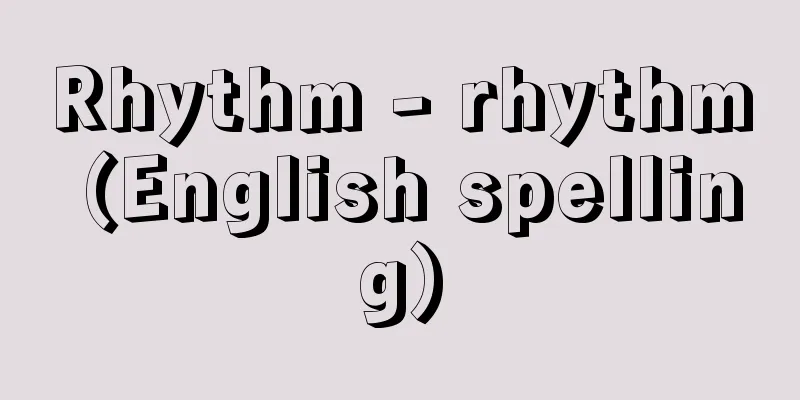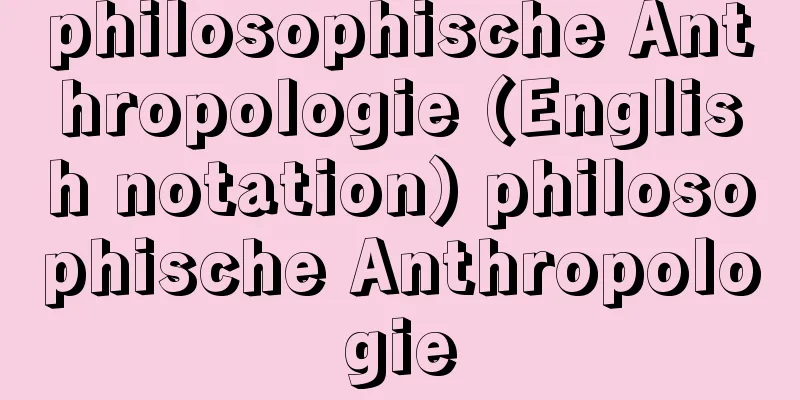Rhythm - rhythm (English spelling)

|
In various human activities, including music, rhythm is the ability to segment and relate the experience of time, which is difficult to grasp in its raw form, and to structure it into a single entity. This word is currently used in a very wide range of applications, including cases where it is translated as "rhythm (movement)" or "synopsis." Rhythm is spoken of in Western music, dance, and poetry, as well as in Eastern music (for example, the Japanese "jo-ha-kyu" and the Indian "tala"), and it is not uncommon to hear physiological rhythms (biorhythms) and natural rhythms (such as the changing of the seasons). All of these usages have in common, at best, the vague image of "temporal change." In modern usage, the rhythm of spatial and visual things is sometimes spoken of, for example, in the phrase "the rhythm of line drawing," and even in this case, the temporality contained in visual experience is implicitly recognized. Furthermore, if we trace the word back to its origin, the Greek word rhythmos, there is a widely held theory that it originally meant "restraint" (Werner Wilhelm Jäger) or "shape, form" (Emile Benveniste); in any case, these are not only unrelated to the modern meaning of the word, but are even the polar opposite. American musicologists G.W. Cooper and L.B. Mayer gave a clear and specific definition of "rhythm," which has a very diffuse meaning, in their co-authored work "Rhythmic Structure of Music" (1960). In it, rhythm is defined along with several related concepts as follows: First, a regular and equal succession of stimuli is called a "pulse." If a distinction between accented and non-accented occurs here for some external or internal reason, it is called a "beat." If this accent appears regularly, it becomes a beat grouping, or "meter." Then, "rhythm" is said to be "the way in which one or more unaccented beats are grouped in relation to one accented beat." This grouping of beats may or may not coincide with the division of the meter. Compared to historically widely known definitions such as "order of motion" (Plato) and "order of time" (Aristoxenus), or historical definitions in musicology such as "immanent dynamics" (Hugo Riemann) and "the perception of original bodily movement" (Ernst Kurt), Cooper and Mayer's definition is distinctive in that it clearly states that rhythm does not exist only as an attribute of an object, but arises in the relationship between the subject and the object in the form of "grouping". Recent psychology has pointed out that humans have a tendency to group and hear even strictly equivalent and equally spaced sound stimuli (i.e. "pulses"). This indicates that the phenomenon of rhythm includes a factor of active involvement on the part of the subject who perceives it. However, actual objects such as poetry and music never have equivalent and equally spaced stimuli, but have various characteristics and each of them requires appropriate segmentation. In short, rhythm is the result of the encounter and interference between a subject that actively tries to group objects and objects that still seek a segmentation appropriate to themselves. This corresponds to the fact that rhythm is incompatible with both an attitude of immersion in objects and an attitude of trying to control them. Rhythm is often classified into three types: (1) metrical rhythm, (2) metrical rhythm, and (3) free rhythm. According to the terminology of Cooper and Mayer mentioned above, metrical rhythm has an even pulse and a regular recurrence of accents, i.e., a meter. This includes most of the music that the average Japanese person hears in their daily lives. Metrical rhythm also presupposes a pulse, but has no accents and does not form a meter. Examples of this are Gregorian chant and Messiaen's "rhythmic music." Free rhythm does not have an evenly-length pulse to begin with, and good examples are Japanese chanting (shomyo) and folk song oiwakebushi. However, the pulse and meter that are the criteria for classification are not always reflected in actual acoustic phenomena. For example, it is safe to say that the first beat of each measure notated in Western music is never uniformly pronounced; they are shifted or evenly balanced. Whether a piece of music has a pulse or meter depends on whether such a framework is established in the consciousness of the person who plays or listens to it. In other words, it is not a matter of phenomenon, but of consciousness. However, this attitude of contrasting a certain framework with actual acoustic phenomena was a characteristic of Western (especially classical) music, and in that sense, it must be fully recognized that this classification is subject to historical and cultural constraints. [Nobuhiro Ito] "The Rhythmic Structure of Music, by G.W. Cooper and L.B. Mayer, translated by Tokumaru Yoshihiko (1968, Ongaku No Tomosha)" ▽ "The Essence of Rhythm, by L. Klages, translated by Sugiura Minoru (1971, Misuzu Shobo)" ▽ "Rhythm and Tempo, by C. Sachs, translated by Kishibe Shigeo (1979, Ongaku No Tomosha)" [Reference] | |Source: Shogakukan Encyclopedia Nipponica About Encyclopedia Nipponica Information | Legend |
|
音楽をはじめとする人間のさまざまな活動において、そのままの形ではとらえにくい時間の体験を、分節し、関連づけることによって、一つのまとまりとして構造化する働き。「律動(動律)」「節奏」などと訳される場合も含めて、この語は現在きわめて広範囲に用いられている。西洋の音楽、舞踊、詩についてはもちろん、東洋のそれら(たとえば、日本の「序破急」やインドの「ターラ」)についてもリズムは語られるし、さらには生理的リズム(バイオリズム)や自然のリズム(季節の移ろいなど)といったものが云々(うんぬん)されることもまれではない。これらすべての用法に共通しているのは、せいぜい「時間的変化」といった漠然としたイメージだけである。現代の用法のうちにも、たとえば「線描のリズム」という場合のように、空間的・視覚的なもののリズムが語られることがあるが、このときも視覚体験のうちに含まれる時間性が暗に意識されている。 さらに語源であるギリシア語のリトモスrhythmosにまでさかのぼれば、この語は「拘束」(ウェルナー・ウィルヘルム・イェーガー)や「形、形式」(エミール・バンベニスト)を表していた、とする説が有力であり、いずれにせよこれらは現代の語義とは無関係という以上に対極的ですらある。 このように非常に拡散的な語義をもつ「リズム」について、アメリカの音楽学者G・W・クーパーとL・B・メイヤーは共著『音楽のリズム構造』(1960)において、明確で限定的な定義を与えた。そこではリズムは関連するいくつかの概念とともに次のように規定される。まず、規則的で等価な刺激の連続は「パルスpuls」とよばれる。ここに外的・内的ななんらかの理由によってアクセントと非アクセントの区別が生じると、それは「拍」(ビート)とよばれることになる。このアクセントが規則的に現れる場合、それは拍群法、すなわち「拍子」になる。そして「リズム」とは「一つ、または一つ以上のアクセントのない拍が、一つのアクセントのある拍との関係でグループ化される仕方」であるとされる。この拍のグループ化は、拍子の区分と一致することもあれば、一致しないこともある。 「運動の秩序」(プラトン)や「時間の秩序」(アリストクセノス)といった歴史上広く知られてきた定義、あるいは「内在するディナーミク」(フーゴー・リーマン)や「本源的な身体運動の知覚」(エルンスト・クルト)といった音楽学史上の定義に比べて、先のクーパーとメイヤーによる定義は、リズムが対象の属性としてだけ在(あ)るのではなく、「グループ化」という形で主体と対象とのかかわりのなかで生じるものなのだ、ということを明確にした点に特色をもっている。近年の心理学では、人間は厳密に等価で等間隔な音の刺激(つまり「パルス」)をもグループ化して聴く傾向をもつ、ということが指摘されている。これは、リズムという現象のうちにはそれをとらえる主体の側の積極的な働きかけという要因が含まれている、ということを示している。しかし他方、実際の詩や音楽といった対象は、けっして等価・等間隔な刺激をもつものではなく、さまざまな特徴を備え、それぞれに適切な分節を求めてもいる。要するにリズムとは、対象を積極的にグループ化しようとする主体と、しかもなお自らにふさわしい分節を求める対象とが、出会い、干渉しあう結果として生じるものなのである。このことは、リズムが対象に埋没する態度とも、それを制御しようとする態度とも相いれないものであることと呼応している。 リズムはしばしば、〔1〕拍節的リズム、〔2〕定量リズム、〔3〕自由リズム、の三つに分類される。前述のクーパーとメイヤーの用語法に従えば、拍節的リズムとは、均等なパルスをもち、しかもそこに規則的なアクセントの再帰、すなわち拍子を備えたもので、平均的日本人が日常生活で耳にする音楽のほとんどがこれに属する。定量リズムは、同じくパルスを前提としながら、アクセントがなく、拍子を構成しないもので、グレゴリオ聖歌やメシアンの「無拍子音楽」がこれにあたる。自由リズムは、そもそも均等な長さのパルスをもたないもので、日本の声明(しょうみょう)の唄(ばい)や民謡の追分節などがその好例である。 しかし分類の基準であるパルスや拍子は、つねに実際の音響現象に示されているわけではない。たとえば、西洋音楽で記譜される各小節の一拍目が一様に際だたされることはまずないといってよく、それらはずらされたり、ならされたりしている。ある音楽がパルスや拍子をもつかどうかは、これを演奏したり聴いたりする者の意識の内に、そのような枠組みが措定されているかどうか、という点にかかっている。つまり、それは現象の問題ではなく、意識の問題である。だが、実際の音響現象に対して一定の枠組みを対置するというこのような態度は、西洋(とくに古典派)の音楽の特質だったのであり、その意味でこの分類が、歴史や文化の制約の下にあるということは、十分意識されていなければならない。 [伊東信宏] 『G・W・クーパー、L・B・メイヤー著、徳丸吉彦訳『音楽のリズム構造』(1968・音楽之友社)』▽『L・クラーゲス著、杉浦実訳『リズムの本質』(1971・みすず書房)』▽『C・ザックス著、岸辺成雄訳『リズムとテンポ』(1979・音楽之友社)』 [参照項目] | |出典 小学館 日本大百科全書(ニッポニカ)日本大百科全書(ニッポニカ)について 情報 | 凡例 |
Recommend
Plain color - Iromuji
[For women] Iromuji is a plain kimono with no patt...
Miyoshi [town] - Miyoshi
A former town in Miyoshi County in the northwest o...
Timasheff, NS (English spelling)
...From the standpoint of seeing the basis of leg...
Hydrophobia - Hydrophobia
〘 noun 〙 = rabies (dog disease) [Orandayakukyo (18...
Oniwayaki
During the Edo period, rulers and wealthy people ...
Karigane Tsutsumi
...Former name of the province. Suruga. Located i...
Shingu [town] - Shingu
An old town in Ibo County in the southwest of Hyog...
Turtle leaf beetle - Turtle leaf beetle
This insect belongs to the family Chrysomelidae, ...
Minshuku - Guesthouse
A lodging facility where private homes offer unus...
Nobuyuki Abe
Army officer and politician. Born in Kanazawa, Is...
"Il Trovatore" - Il Trovatore
...However, an unexpected turn of events leads to...
Aelianus
…Originally from Celtic, it means “fighter” or “c...
Heterotrephes admorsus (English spelling) Heterotrephes admorsus
… Stink bugs with the name water bug include the ...
Katanatori
...There is a record of the emperor seeing this i...
Songkhla (English spelling)
A town on the east coast of the Malay Peninsula in...









